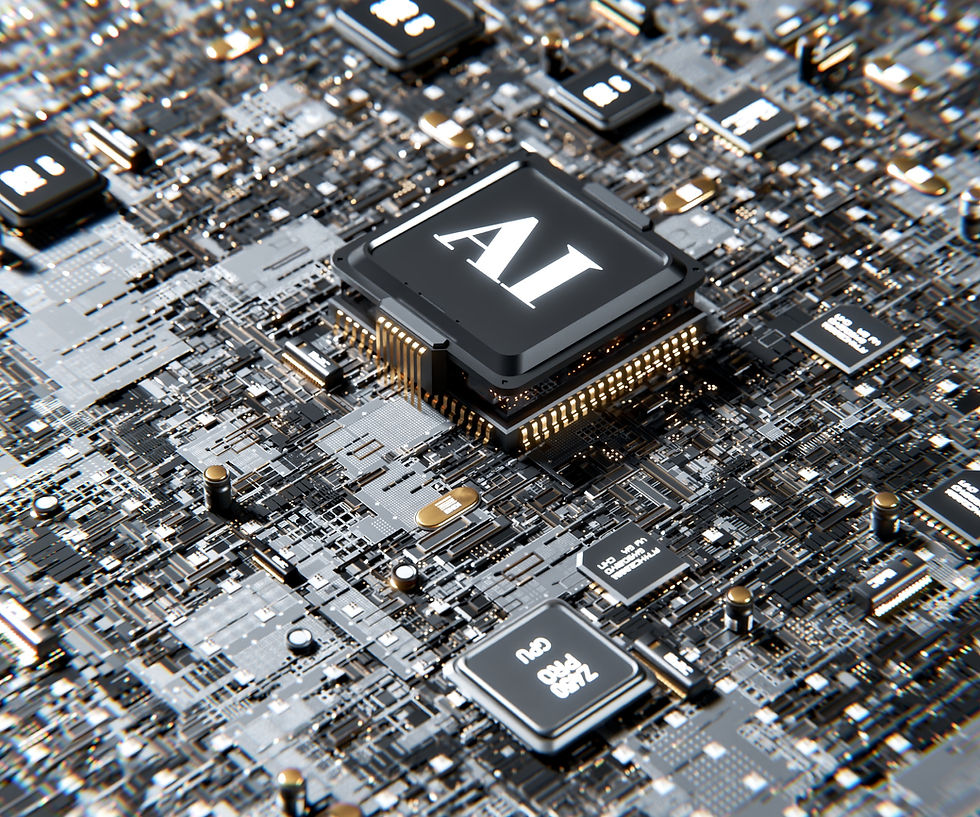Introduction to AI & Machine Learning Basics – How Machines Are Learning to Think
- Kunal Dhingra | Ceresphere Consulting

- Jun 9
- 3 min read
Artificial Intelligence (AI) isn’t a futuristic dream—it’s already transforming businesses in ways that range from personalized recommendations to automated customer service. At the heart of AI is Machine Learning (ML)—the technology that enables systems to learn from data and improve over time. Whether it’s predicting customer preferences or optimizing financial decisions, AI and ML are reshaping industries and accelerating digital transformation.

Let’s break down what AI and ML really mean, how businesses use them, and why they matter now more than ever.
1. What Is Artificial Intelligence (AI)? (AKA: “Teaching Machines to Think Like Humans”)
AI refers to the ability of machines to mimic human intelligence—helping systems solve problems, recognize patterns, understand language, and make smart decisions automatically.
Examples of AI in Action:
✔ Chatbots that handle customer queries (without needing coffee breaks!)
✔ Recommendation engines that predict what you want before you know it (Netflix, Amazon)
✔ Autonomous vehicles that analyze surroundings and drive safely (without complaining about traffic!)
Real-World Example: AI in E-Commerce:
How AI transforms online shopping:
✅ Predicts customer preferences for personalized product recommendations.
✅ Automates chat support to answer customer questions instantly.
✅ Uses AI-driven analytics to optimize inventory management.
Impact?
✔ Higher sales conversions thanks to targeted suggestions.
✔ Faster customer support improves satisfaction.
✔ Optimized stock levels reduce waste and improve supply chain efficiency.
AI isn’t just thinking—it’s helping businesses make data-driven decisions faster.
2. What Is Machine Learning (ML)? (AKA: “Making Machines Smarter Over Time”)
Machine Learning (ML) is a subset of AI focused on building systems that learn from data and improve without explicit programming. ML works by feeding algorithms large datasets, allowing them to identify patterns, make predictions, and refine outputs over time.
Types of Machine Learning:
✔ Supervised Learning – Learns from labeled data (like predicting loan approval).
✔ Unsupervised Learning – Finds hidden patterns in unlabeled data (like customer segmentation).
✔ Reinforcement Learning – Learns through trial and error, adjusting based on rewards and penalties (like self-driving car training).
Real-World Example: ML in Financial Services
How ML enhances banking & credit approvals:
✅ Analyzes customer behavior to assess creditworthiness.
✅ Detects fraud by identifying suspicious transaction patterns.
✅ Automates loan approval processes, reducing human intervention.
Impact?
✔ Faster, more accurate loan processing (30% improvement).
✔ Reduced fraud risks with AI-driven security checks.
✔ Better financial insights for personalized banking services.
ML isn’t just learning—it’s helping businesses scale smarter, faster, and more securely.
3. How AI & ML Are Used in Business – Real-World Applications
AI and ML aren’t just for tech giants—they’re shaping everyday operations across industries.
Business Use Cases:
Sales & Marketing – Predictive lead scoring, personalized campaigns, customer sentiment analysis.
Operations – Automated logistics, demand forecasting, supply chain optimization.
Finance – Fraud detection, credit scoring, predictive analytics.
HR – Resume screening, employee sentiment analysis, automated hiring decisions.
Real-World Example: AI-Driven Customer Support
How businesses use AI-powered chatbots:
✅ Automates common inquiries, reducing human workload.
✅ Learns from conversations to improve responses.
✅ Personalizes interactions, boosting customer satisfaction.
Impact?
✔ Lower operational costs—fewer human agents needed.
✔ Faster response times—customers get instant help.
✔ Improved accuracy—AI suggests better solutions based on past queries.
AI-powered automation isn’t just saving time—it’s improving business efficiency.
4. Benefits of AI & ML – Why Every Business Should Care
Top advantages driving AI adoption:
✔ Increases efficiency – Automates repetitive tasks, freeing up employee time.
✔ Enhances customer experience – Personalizes interactions, making brands more customer-friendly.
✔ Improves decision-making – Provides real-time insights for smarter business strategies.
Real-World Example: AI-Powered Predictive Analytics in Retail
How retailers use AI for demand forecasting:
✅ Predicts seasonal shopping trends, optimizing stock levels.
✅ Analyzes purchase behavior to adjust pricing dynamically.
✅ Automates inventory restocking, preventing shortages.
Impact?
✔ Less overstock waste—higher profit margins.
✔ Smarter pricing strategies based on customer demand.
✔ Faster inventory turnover, improving cash flow.
AI isn’t just improving efficiency—it’s shaping entire industries with intelligent automation.
Final Takeaways – Why AI & ML Are Essential for Digital Transformation
AI and ML aren’t just buzzwords—they’re the backbone of modern digital strategy.
AI mimics human intelligence to optimize business functions.
ML enables systems to learn from data, improving predictions over time.
Businesses can apply AI/ML across departments to gain speed, insights, and scalability.
Understanding AI & ML basics is the first step toward digital transformation success.
The BIG question: Is your business embracing AI-powered innovation, or waiting while competitors gain the advantage?
AI and ML aren’t futuristic concepts anymore—they’re essential capabilities shaping tomorrow’s leading businesses. Organizations that adapt now will lead—those that hesitate will struggle to keep up.
Facing Challenges in digitization / marketing / automation / AI / digital strategy? Solutions start with the right approach. Learn more at Ceresphere Consulting - www.ceresphere.com | kd@ceresphere.com





Comments